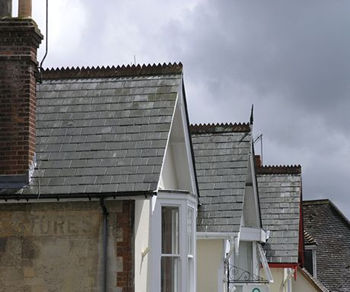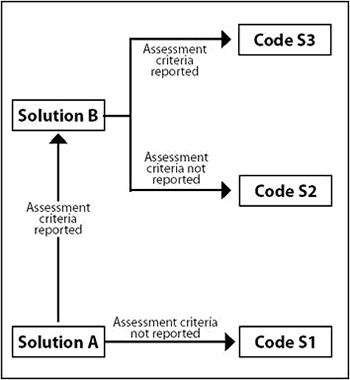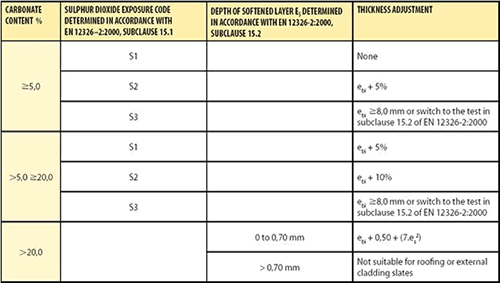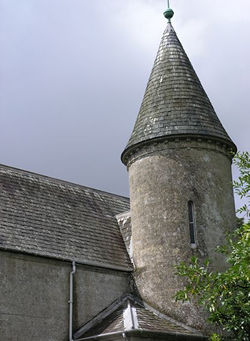Testing Roofing Slates
New standards and a new specification regime
Terry Hughes
 |
Where historic buildings are to be reslated, the new slates should always match the existing. However, a decision based on historic precedent may not be possible because the original quarry is no longer in production. In these cases slates conforming to a recognised standard should be specified, but with the advent of a European standard, care will also be needed to ensure that the chosen slate has a satisfactory life-expectancy.
Since 1942 the British Standard for testing roofing slates has been BS680. This will soon be replaced with two new standards which will apply throughout Europe. BSEN 12326-1 Slate & Stone Products for Roofing sets out the conformity requirements which are in the main established against a set of tests described in BSEN12326-2. Under the rules for writing European Standards every product which was on the market at the start of the process had to be accommodated within the standard’s requirements, consequently, there are different levels of conformity for each test to take account of the different durabilities of different slates and their local market expectations. Because of the long history of use of their own slates, some countries are happy with slates which do not last as long as would be expected in the UK. This means that contractual specifications for roofing slates will need to be more sophisticated than in the past. It is no longer sufficient to specify ‘slates which conform to the relevant British Standard’ or even ‘slates which conform to BSEN12326-1’. Such blanket specifications would allow slates to be supplied at the lowest conformity level within the standard and this could mean a life of 40 years or less.
DURABILITY
TESTS
Metamorphic slates
are formed by the action of heat and pressure acting over hundreds of
millions of years on consolidated clays (muds) which were deposited under
water. Rarely they may be formed by the same process acting on volcanic
ash similarly laid down and compacted. The process of metamorphism involves
heat and pressure and is quite moderate or low grade but takes place over
a millions of years. The heat and pressure together cause the clay minerals
to recrystalise and to align themselves with their long axis perpendicular
to the direction of pressure. It is this mineral alignment which imparts
the property of ‘slatey cleavage’ and which allows the rock to be split
into thin, strong sheets.
 |
|
| Figure 1. This slate contains veins of metallic minerals which have oxidised. Eventually they will all split along the vein. | |
 |
|
| Figure 2. These slates have failed the sulphur dioxide exposure test. |
The predominant and most important clay minerals are phyllosilicates such as muscovite and chlorite, which are stable. Slate may, however, contain other minerals which are unstable and which can seriously reduce the durability of roofing slates.
The durability of slates depends on their structure and the presence or absence of deleterious minerals. A slate with a good structure will have low water absorption and this also indicates resistance to frost. Problematic minerals include carbonates, metallic sulphides which oxidise on exposure and carbon in the form of graphite. Carbonates and metallic minerals are tested in ways which simulate and accelerate exposure on a roof and for carbon there is a maximum permitted content of two per cent.
Water absorption is tested by weighing oven-dried samples before and after immersion in water for 48 hours. The maximum acceptable value is 0.6 per cent but because there are always questions about the durability of slates with slightly greater absorptions, there is an additional freeze/thaw test for these. In this the strength of slates is tested before and after exposure to 100 cycles of freezing and thawing. If the water absorption is 0.6 per cent or less this test is not required.
 |
|
| Figure 3. Coding system for the sulphur dioxide exposure tests. |
Metallic sulphides are often known generically (and inaccurately) as iron pyrites, and if the crystals are large these can be seen as cubic brassy inclusions in the slate. Some, such as pyrrhotite and marcasite, oxidise (see Figure 1) but others do not. Ballachulish slates, for example, include large crystals but they are stable and have a very long life. The reaction of metallic sulphides is tested by exposure to 20 wetting and drying cycles. Depending on the changes which result (swelling, splitting, flaking, oxidative colour-changes (rusting), or exfoliation) a code is applied – T1, T2 or T3. A T1 slate shows no structural effects or only surface colour changes. At the other extreme the changes in T3 slates will result in holes and are only acceptable where the manufacture and roof slating systems ensure that water will not get into the roof. Such systems exist in France but in the UK the roofing industry is not set up to deal with this issue. This is an example of how the standard has had to be tailored to suit particular markets.
Carbonates such as calcite, dolomite and siderite are susceptible to decay in both polluted and unpolluted environmental conditions. The original minerals become converted to other minerals which may be soluble and may be volumetrically larger. Both these effects will tend to weaken and disrupt the structure of the slate. In general, and for homogeneous concentrations of between three per cent and 20 per cent, the severity of the effect is directly proportional to the concentration of carbonate present. Inhomogeneous (localised) concentrations of carbonates such as those occurring in veins or nodules can result in very rapid reactions resulting in the formation of holes or the complete break up of the slate. The reaction of these minerals is tested by sulphur dioxide exposures using one of two procedures depending on the carbonate content. Slates with a content of 20 per cent or less are exposed over each of two concentrations of sulphurous acid for 21 days or until they fail (subclause 15.1 in Table 1). Depending on whether the samples show the assessment criteria – splitting or cracking of the edges and swelling, softening or surface flaking (see Figure 2) – in either acid solution a code S1, S2 or S3 is allocated (Figure 3).
Where the carbonate
content is more than 20 per cent, the samples are also exposed to sulphur
dioxide but their reaction is measured by scraping the surface and measuring
the depth of the groove (subclause 15.2 in Table 1).
It is important
to understand that some slates which contain carbonate can have a long
life because the mineral is dispersed within the structure and they are
made comparatively thick. Westmorland Green slates are one example. To
take account of this, the standard specifies minimum thicknesses in relation
to the slate’s performance in each of the sulphur dioxide tests – (see
Table 1). (ebi is the basic individual thickness of the slates. The standard
gives a full explanation of this.) If slates contain native carbon, rather
than carbon combined in a mineral such as calcium carbonate, it can weather
out very quickly. There have been examples where the roofing slate was
actually made up of alternating layers of slate and carbon and within
a few months after installation the slates delaminated. For conformity
with the standard the measured non-carbonate carbon content must not exceed
two per cent.
STRENGTH
AND THICKNESS
Strength is the most
important property of roofing slates. The obvious reason for this is that
they need to be strong enough to be handled on site and to resist the
loads they will experience on a roof. Less obvious perhaps, that the formal
definition of their durability that they reach the end of their life when
they have become too weak to resist those loads and they snap in the wind.
But strength is also fundamentally important to the economics of their
manufacture and therein lies a problem. Slates are made by quarrying rock,
cutting the blocks to size and then splitting them as thinly as possible.
The cost of everything up the point of splitting the slates is more or
less constant. But to be able to split a 25mm thick block into five rather
than four individual slates can make all the difference to whether a quarry
is profitable.
 |
|
| Table 1. Minimum individual thickness in relation to carbonate content and sulphur dioxide exposure code |
So the question arises;
why not split them all as thin as possible? The answer is that they might
not be strong enough. The strength of individual slates is a product of
the rock’s strength and the slate’s thickness. A thin slate made from
strong rock will be as strong as, or stronger than, a thick slate made
from weak rock. The traditional thicknesses of slates in the UK have evolved
so that they are made thick enough to resist the loads they will be exposed
to on a roof, so the inherently weaker rocks are split 8 to 12mm thick
whereas the strongest will be as thin as 4mm. What has gone wrong recently
is that imported slates made from inherently weaker rocks have been split
to traditional UK thicknesses of about 5mm. The consequence is that on
a roof the thinnest slates in a consignment break during the
first winter.
They don’t all break of course because within the range of thicknesses
in a consignment some, probably most, will actually be strong enough.
But this is no comfort when five per cent of a new roof is lying on the
ground, even if they didn’t hit anyone on the way down.
Because strength was not an issue when BS680 was written 60 years ago, a strength test was not included and this has been a problem in the face of weak imported slates. Happily, the new standard deals with this issue. Firstly, the rock strength, the ‘modulus of rupture’, is measured on a sample of 40 test pieces and from this characteristic strength values along and across the slates are determined. These values can then be applied to an equation which gives a minimum basic slate thickness, ebi. It is at this stage that any adjustments resulting from the sulphur dioxide tests are applied to the basic thickness. Manufacturers must then ensure that no slate is thinner than this value. Because slates are sold on the basis of nominal thickness, if the range variation is large the nominal thickness will be much larger than the minimum. If the variation is small then they will be much closer. This process ensures that slates will be technically satisfactory but there is an alternative route where it is important for conservation reasons to use thicker slates. These may be specified on the basis of traditional construction methods. Obviously it would be unwise to use this alternative to specify thinner slates than required to resist the wind loads.
 |
DIMENSIONAL
REQUIREMENTS
All slates require
a good standard of skill and experience on the part of the slater. One
of the most important aspects of this is taking care to deal with the
dimensional variations from slate to slate. To make this easier and
hence to ensure the slating cost is reasonable, limits are set on the
variations in length, width, edge straightness, rectangularity, fl atness
and thickness, and there are tests for each of these. Most of these
limits do not apply to random sized slates because their dimensions
are undefi ned.
PETROGRAPHY
The standard includes a petrographic (or geological) assessment, but this is not part of the durability testing. It is simply included to enable the origin of slates to be decided if there is a dispute about the source. It should not be called up in a specifi cation to decide if a slate is technically suitable.
APPEARANCE
Except for those
aspects of surface texture which affect fl atness, there are no requirements
for appearance in the standard. All of these, especially colour and
colour changes must be agreed between supplier and specifi er or purchaser.
Colour is a particularly diffi cult property to standardise because
it changes over time both in the quarry and after installation and it
can look very different in the hand and on the roof. Because some slates
with a high carbonate content – say more than 20 per cent – can change
colour from black to white in a matter of months, it would be wise to
get a clear statement from the manufacturer on this issue.
OTHER REQUIREMENTS
There are some requirements for fi re performance and safety which are common to all building materials but which do not have serious implications for the use of slates. After many years of wrangling over fi re tests it has been decided that for external fi re performance and reaction to fi re, slates are deemed to satisfy and do not need to be tested. Natural slates also do not release dangerous substances and manufacturers do not need to make declarations on this issue.
PRODUCT
CONFORMITY
Any manufacturer
claiming conformity to BSEN12326-1 must provide the following information
on the accompanying commercial document (the delivery note, invoice
or supplier’s certificate) which must be supplied with a consignment
of slates:
- the number and
date of the European standard
- the name, trade
mark or other means of identifi cation of the manufacturer
- the commercial
name of the slate and its slate type description; nominal thickness,
size and shape
- the name of the
district, county or province in which the quarry or mine is situated
- the year of manufacture
- a report containing
the following information:
(a) the latest test results for each test
(b) the date(s) of samplingthe
(c) the date(s) of tests
(d) the test methods applied
(e) the requirements of this standard for each test
The standard also provides a format for this in two parts. The fi rst is the test results and the second, because the issues are quite complex, is an explanation of what the results mean and what the standard requires. The declaration of test results is not complete without both parts. An example of a report can be seen at www.slateroof.co.uk/report.pdf
The formalisation of the conformity declaration will go a long way to overcoming some of the worst abuses which have been common in recent years. However, any test certifi cate will only be representative of a small number of test slates. What is far more important is evidence of on-going conformity over a long period of time, ideally where the sampling is carried out independently of the manufacturer. The best way to obtain this is to choose a manufacturer with a management system based on the BSEN29000 series of quality assurance standards. They should be able to supply test results obtained over many years including certifi cates from independent organisations.
SPECIFICATION
WRITING
It should now be
clear that writing a slate specifi cation is going to be a bit more
diffi cult than in the past. Besides the name of the slate and its size
and thickness it will be essential to ensure that the required performance
level is established for several tests. The table of test results as
shown in the accompanying commercial document could be used for this
but a dialog with the manufacturer will be necessary to make sure it
is appropriate for any particular slate.



